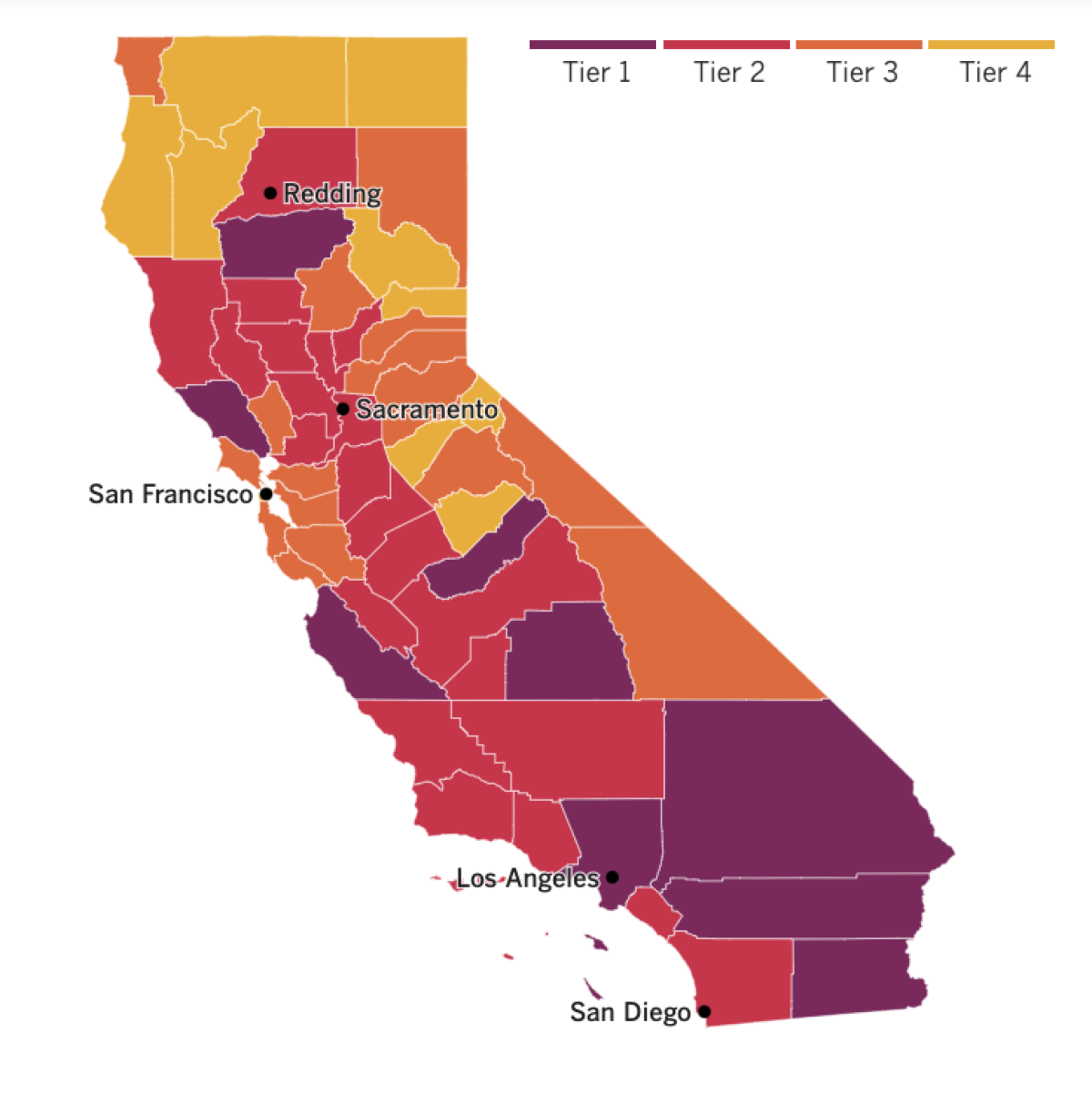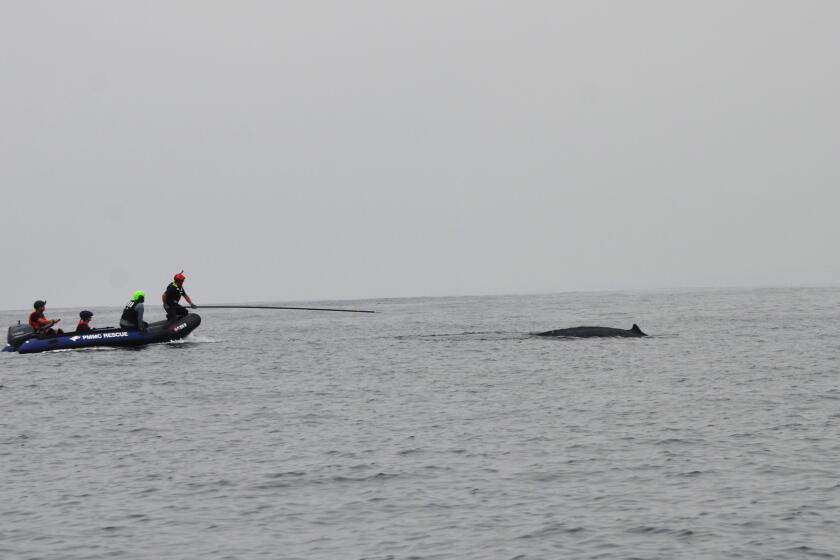Coronavirus Today: The contagion at Trump rallies
Good evening. I’m Amina Khan, and it’s Monday, Nov. 2. Here’s what’s happening with the coronavirus in California and beyond.
For the record:
6:50 p.m. Nov. 3, 2020A previous version of this newsletter stated President Trump held a rally in Boise, Idaho, in late October. The rally was staged by Trump supporters, but the president was not there.
President Trump and former Vice President Joe Biden have both campaigned in key battleground states, but their events have looked very different. Biden has spoken to supporters at drive-in, socially distanced affairs, while Trump has favored traditional in-person rallies, as if there weren’t a pandemic going on. Trump’s choice has had deadly consequences, according to a study by Stanford researchers.
Their analysis of 18 of the president’s rallies suggests that the events have resulted in more than 30,000 additional coronavirus infections and at least 700 additional COVID-19 deaths. None of these infections or deaths would have happened if those rallies hadn’t taken place, the researchers said.
However unwittingly, these campaign events allowed economist B. Douglas Bernheim and his colleagues to measure the super-spreading potential of mass gatherings. Attendees of the Trump rallies made little effort to follow guidelines about social distancing, and mask use was optional (not to mention derided from time to time by the president himself). Three of the 18 events were held indoors, raising the risk of coronavirus transmission even further.
Each county that hosted an event was compared with at least 100 others that had similar trajectories of COVID-19 cases in the preceding weeks but that Trump did not visit. The researchers discovered a clear pattern — the political gatherings likely triggered long and unpredictable chains of transmission in their communities.
These chains often infected people far outside the initial circle of attendees. My colleague Melissa Healy gives a hypothetical example: “An infected rallygoer might pass the virus to her grocer, who may pass it to his teenage son, who transmits it to his girlfriend, who could infect her piano teacher.”
Two rallies in Wisconsin — one Aug. 17 in Oshkosh and another Sept. 17 in Mosinee — stood out. Before these rallies, the positivity rates for coronavirus tests in both host counties were basically flat. But they took sharp, upward turns after the president visited.
The scientists used statistical methods to try to account for other possible differences between counties that could explain the rise in cases, such as how many people lived near each other, the strength of local public health restrictions and how common it was for residents to have underlying medical conditions. They even made sure the 18 counties were matched against other counties that had the same level of support for Trump in 2016.
The study findings quickly made their way to the campaign trail this weekend, with a Biden spokesman calling the Trump rallies “super-spreader events that only serve his own ego.” The Trump campaign responded that attendees were exercising their 1st Amendment rights and had been required to submit to temperature checks to enter. (They also were given masks and hand sanitizer.)
With election day upon us, the rallies have come to an end. But the lessons of the study will endure: Don’t gather in large groups, do wear a mask, and stand at least six feet apart from other people.
By the numbers
California cases and deaths as of 7:19 p.m. PST Monday:

Track the latest numbers and how they break down in California with our graphics.
See the current status of California’s reopening, county by county, with our tracker.


Consider subscribing to the Los Angeles Times
Your support helps us deliver the news that matters most. Become a subscriber.
Across California
Students in L.A. Unified schools are suffering, and their grades show it. Ds and Fs have shot up for middle and high school students, a clear sign that distance learning isn’t working for many children. The poor grades rose most sharply for students from low-income families, according to data based on 10-week interim assessments. The surge in failing grades for these students mirrors their lower attendance rates.
“They’re eager to learn and every bit as capable as they were before school facilities closed,” said LAUSD Supt. Austin Beutner. “But the struggle to cope with COVID-19 and online learning for children and their families is very real.”
Last week, school board leaders said most students will not return to campus before January. But teachers interviewed by The Times say they’re struggling to keep students learning and engaged.
Sharonne Hapuarachy, who teaches English at Dorsey High School in Baldwin Hills, said she calls parents and tracks down students to ensure they attend her classes. That work has paid off — absentee rates among her 11th- and 12th-grade students dropped from about half in the spring to around 25% this semester. Still, many of her pupils have to miss school to work and support their struggling families, and some have had family members sickened by COVID-19. She said she started giving lessons on mindfulness, deep breathing and meditation to help students manage and relieve some of their stress.
“I’ll ask them, ‘Is this helpful? Is it too weird?’ and they’ll tell me that they feel so much more calm and that they wish they could do it longer,” Hapuarachy said.
Another vulnerable group are California’s prisoners. So far, more than 15,800 confirmed cases have been reported behind bars, including 570 new infections in the last two weeks. Three incarcerated people died of COVID-19 in the past week, bringing the total number of documented deaths to 79. With about 161 infections per 1,000 people, incarcerated Californians face a coronavirus risk that’s nearly seven times higher than that of Californians overall.
From the upper reaches of the state comes a story of a powerful megachurch in Redding and the outsize influence it wields. In this economically stressed city, masks are shunned by young people reading Bibles in coffee shops, and believers walk up to strangers, asking to pray for them and heal them. But Bethel Church has drawn ire after its members and students helped fuel a spike in coronavirus that briefly sent Shasta County back down to the most restrictive tier in California’s reopening plan.
“The perception from that is they don’t really care,” one Shasta County supervisor said. “What we tried to tell them is, if you really want to be part of the community, you have to do more to respect the community.”
Kris Vallotton, a co-founder of the church’s Bethel School of Supernatural Ministry, sees things differently. “I am willing to sacrifice for my job, my students, my coworkers, my city ... But I’m not willing to, like, give up my life,” he said. “I’m not willing to stop living because there’s a pandemic.”
Finally, if you need a little respite from straight pandemic news, check out the lineup for the third week of the 25th Los Angeles Times Festival of Books.
On Wednesday, we’ll have Sandy Banks moderating a conversation about the Black experience, covering race, family and society. Thursday will feature novelist Elissa Sussman in a conversation with authors Jasmine Guillory, Casey McQuiston and Rebekah Weatherspoon on their modern romance novels. On Friday, students from USC Glorya Kaufman School of Dance will host a performance framed by a discussion on the historical context of the dance styles featured. All events are free.
Resources
— For general safety, wash your hands for at least 20 seconds (here’s a super-fun how-to video). Stop touching your face, and keep your phone clean. Practice social distancing, maintaining a six-foot radius of personal space in public. And wear a mask if you leave home. Here’s how to do it right.
— Watch for symptoms including fever, cough, shortness of breath, chills, repeated shaking with chills, muscle pain, headache, sore throat and loss of taste or smell. If you’re worried you might be infected, call your doctor or urgent care clinic before going there.
— Need a COVID-19 test? Here’s how to receive a free test if you’re in L.A. County. And here’s a map of testing sites across California.
— Here’s how to care for someone with COVID-19, from monitoring their symptoms to preventing the virus’ spread.
— If your job has been affected by the pandemic, here’s how to file for unemployment.
— Here are some free resources for restaurant workers and entertainment industry professionals having trouble making ends meet.
— Advice for helping kids navigate pandemic life includes being honest about uncertainties, acknowledging their feelings and sticking to a routine. Here’s guidance from the CDC.
— In need of mental health services? Here are resources for coping during the crisis from the CDC and the L.A. County Department of Mental Health. L.A. County residents can also call (800) 854-7771 or text “LA” to 741741.
— For domestic violence victims, the pandemic can pose a “worst-case scenario,” advocates say. If you or someone you know is experiencing such abuse, call the National Domestic Violence Hotline at 1-800-799-SAFE (7233) or L.A. County’s hotline at 1-800-978-3600. Here are more ways to get help.
Around the nation and the world
It’s official: California no longer holds the dubious title of the state with the highest number of coronavirus cases. That distinction now belongs to Texas, even though it has 10 million fewer residents, according to data compiled by The Times. As of Monday morning, the Lone Star State’s recorded total of 936,816 cases edged out the Golden State’s 935,534.
When you take into account California’s much higher population, there’s no competition: Texas’s case rate of about 3,359 infections per 100,000 residents is way above California’s rate of around 2,389 per 100,000.
“We’ve got to overcome any sense of fatigue that we might have,” said Dr. John Hellerstedt, commissioner of the Texas Department of State Health Services. “We have to understand how important this is, and I’m asking you, please, to redouble your efforts to take the precautions that we’ve asked you to do and that we have proven that work.”
My colleague Maria La Ganga offers a postcard of pandemic-tinted political life from Boise, Idaho, where Trump supporters held a rally in late October and where somewhat tightened restrictions to battle the virus were decried by a swath of Republican legislators — not to mention the state’s own Lt. Gov. Janice McGeachin. Idaho doesn’t have the economic heft of a state like California or the allure of a battleground state like Pennsylvania, but it may serve as a bellwether of “Republican fervor and leave-me-alone independence,” La Ganga writes. Both have taken center stage in the midst of this singular election year.
In the United Kingdom, where coronavirus cases have surpassed 1 million, British Prime Minister Boris Johnson announced a new lockdown for England that will begin Thursday and last until Dec. 2. The announcement marked a sharp change in direction for Johnson, who came under rising pressure to act as researchers warned that COVID-19 hospitalizations and fatalities could soon pass this spring’s peak, at 1,000 deaths per day. Other parts of the U.K. set their own policies, with Wales and Northern Ireland already effectively in lockdown and Scotland under tough regional restrictions.
France, Germany and Belgium have also imposed new lockdowns as they fight to contain a surge in caseloads.
In Mexico, Día de los Muertos celebrations took place under the pandemic’s pall. COVID-19 has killed more than 90,000 people there, making the country fourth in the world in coronavirus-related deaths.
“This virus is truly a tragedy,” said Javier Suárez, 68, who had traveled an hour and a half from his home to the burial ground where his mother lies, only to be denied entry at the gates. “It kills thousands of people. And it leaves those of us left alive filled with fear,” he said. “Now this COVID is destroying our traditions.”
The muted celebrations also point to a larger picture of economic distress for the millions of Mexicans whose livelihoods depend on street commerce. Day of the Dead paraphernalia sales this year were predicted to plunge by 70% or more.
Your questions answered
Today’s question comes from a reader who wants to know: If you were the U.S. virus czar and could wave your magic wand, what are the three things you would do right away to control this virus without shutting down the economy?
Linda Dickey, director of the epidemiology and infection prevention program at UCI Health, shared what she’d put on her list:
1. Mandatory masks: “Face coverings are effective to reduce the risk of spreading COVID-19,” Dickey said. “This is a simple, low-cost way to increase safety for ourselves and others.”
2. Mandatory influenza vaccination for those who can get it safely: If you reduce the risk of getting the flu this season, you will also “reduce the risk of co-infection with COVID-19,” a scenario that would lead to more cases of severe disease as well as more deaths, she said. It will also reduce the risk of mistaking symptoms of COVID-19 for the flu.
3. Mandatory hand hygiene to gain entry to any public location: “It goes without saying that hand hygiene is effective in reducing the spread of germs,” Dickey says, calling it “a fundamental infection-prevention strategy.”
Dickey is not an outlier. Public health authorities strongly encourage masking up in public places and washing your hands or using hand sanitizer frequently.
In answering a previous question from a reader, Dr. Peter Chin-Hong, an infectious disease specialist at UC San Francisco, suggested that people look for the “four Ws” when visiting hospitals: mask-wearing, watching your distance, washing your hands and wind (i.e. high-quality ventilation).
I’m going to go out on a limb here and say that those seem like good things to look for when entering any interior public space.
Our reporters covering the coronavirus outbreak want to hear from you. Email us your questions, and we’ll do our best to answer them. You can find more answers in our Frequently Asked Questions roundup and in our reopening tracker.
For the most up-to-date coronavirus coverage from The Times over the weekend, visit our homepage and our Health section, sign up for our breaking news alerts, and follow us on Twitter and on Instagram.




